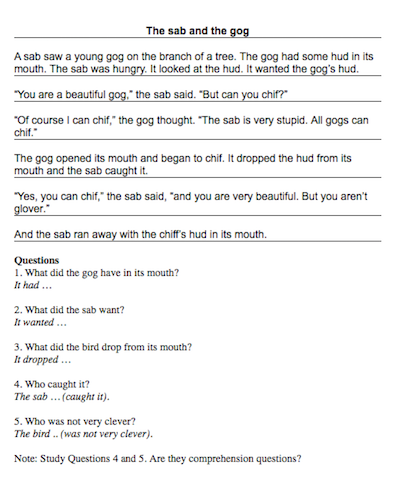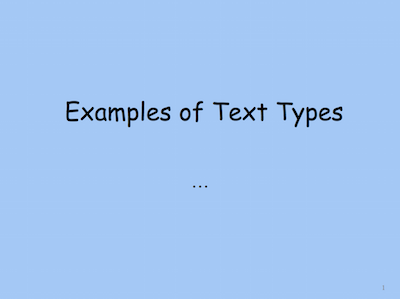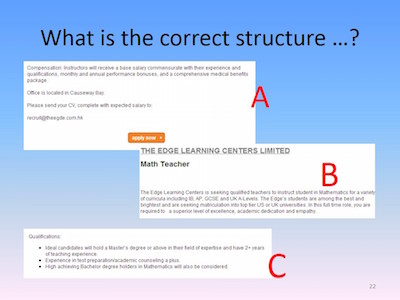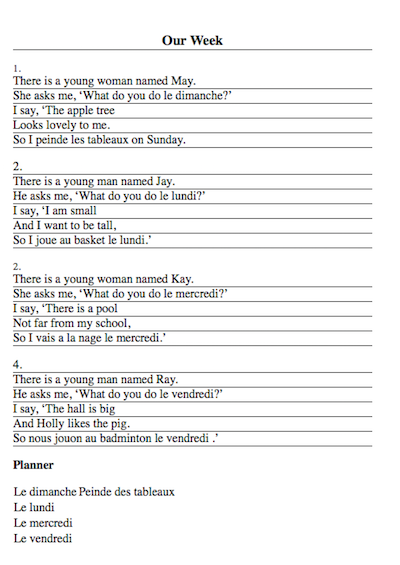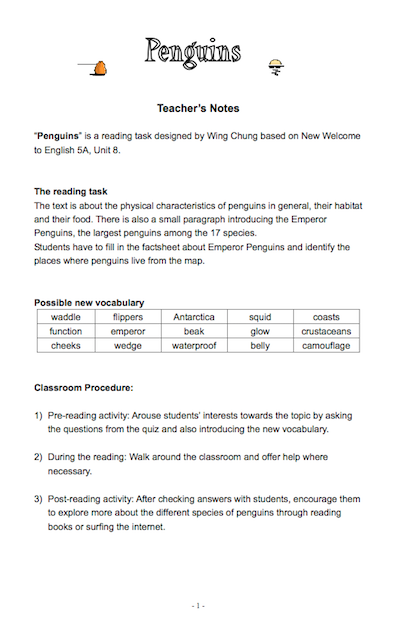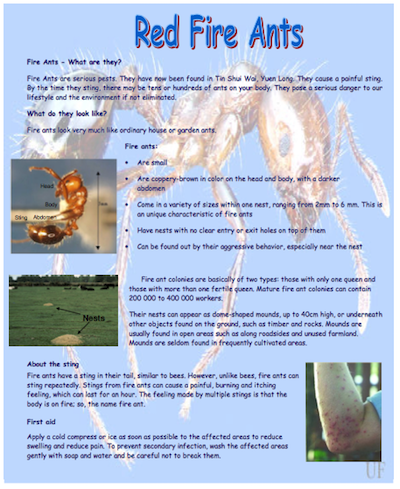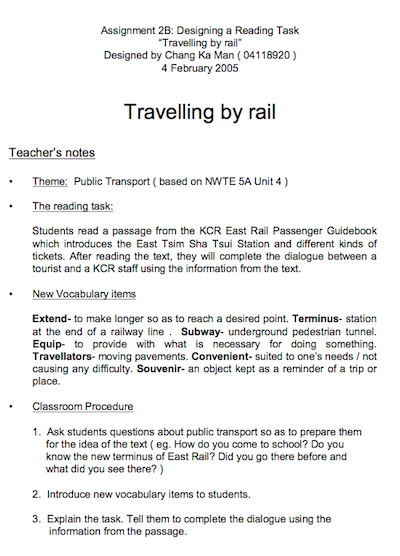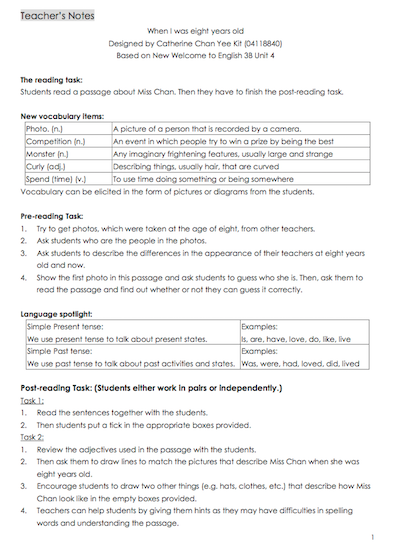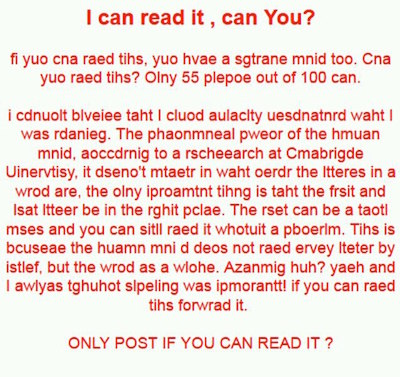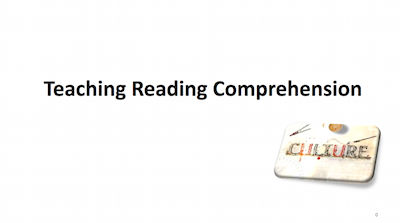Teaching Reading Comprehension
Objective: To explain how to present text types and how to design reading tasks that develop students’ reading skills and strategies.
Watch the following pre-class video, and then do the quiz. Please note the deadline for completing the pre-class Quiz.
Limitations of Traditional Reading Comprehension Teaching
Step 1:
Open the ‘Sag and Gog’ passage. Read the passage. Look at the reading comprehension questions at the end of the passage.
Step 2:
Answer the questions on the Word document.
Step 3:
When you have finished, the instructor will choose some of the attempted answers to show to the class using ‘Show Student’s Screen’.
Step 4:
What do you perceive to be the limitations of traditional reading comprehension teaching? Share your thoughts with the class.
What are Text Types?
Step 1:
Open the PPT titled ‘Examples of text types’. View the PPT in ‘edit’ mode. Each slide will present one example text type.
Step 2:
Think of a term usually used to refer to each text type. Enter the term in the heading box of each slide/text type.
Step 3:
When you have finished, the instructor will show some of your attempted answers to the whole class.
Thinking About the Organization of a Text Type
Step 1:
Look at a picture which shows, randomly, 3 parts of a job advert in the newspaper.
Step 2:
Sequence the 3 parts in the correct (i.e., original) order.
Step 3:
Join another student. Compare your answers. Then, discuss the usual organization of a newspaper job advert.
The Official Inventory of Text Types and Reading Skills
The 2004 Primary English Curriculum has set out an inventory of text types to be covered in KS1 (Lower Primary), and in KS2 (Upper Primary), as well as an inventory of Reading Skills to be covered in KS1, and in KS2
Identifying Target Reading Skills
Step 1:
Study the text Dress Casual Day from a P3 coursebook.
Step 2:
Look at the 4 MC questions that follow the text. Examine each question carefully, and try to identify the reading skill(s) that it involves. Note down your thoughts (the reading skills involved) for each question. Refer to the resource “Reading Skills from the 2004 Curriculum”.
Step 3:
Join another student. Compare your thoughts. Then exchange views on the questions.
Thinking about How to Teach Reading Comprehension in the Classroom
View 3 short clips showing 3 ways a teacher teaches reading comprehension in the classroom. Are they effective? If not, why not?
Be prepared to share your views with the whole class.
A Three-Phase Task-Based Reading Unit
Consistent with the current task-based approach to language teaching, the teaching of reading often engages learners through a series of tasks. These learning tasks are carried out in different stages of a teaching unit on reading. The stages are called Pre-reading; While-reading; and Post-reading.
Your instructor will give a short presentation on the purpose and what to do for each of the three phases.
Listen carefully, and you may be asked to apply the principles in designing a teaching unit on reading.
A Sample Three-Phase Task-Based Reading Unit
Read the task material for the reading unit ‘A trip to Shenzhen’ and the accompanying teacher’s notes. Pay attention to how a three-phase teaching unit can be developed from the reading text.
Analysing a While-Reading Task in a Coursebook
Do this in pairs.
Step 1:
Look at a reading text and its accompanying reading task from a P2 coursebook. What do you think about the reading task?
Step 2:
Now, try the French version of the same text and task.
Step 3:
Now, try an adapted version of the original coursebook task. Does it require understanding this time?
Designing a Pre-Reading Activity for a Reading Unit
Step 0:
Skim through the Pre-reading section of the teacher’s notes for ‘A Holiday in Shenzhen’ (page 3 of the PDF file).
Step 1:
Imagine that you’re going to teach ‘Dress Casual Day’ to a P3 class. Study the text, and think of a pre-reading activity.
Step 2:
When you have finished, join 2 to 3 other students and exchange your ideas.
To Explore Further
A. Below are reading texts and tasks that have been developed by other student teachers.
The Art of Sushi by Rossetti Lo
Disneyland by Esther Wong
Fire Services in HK by Maria Wong
Penguins by Wing Chung
Red Fire Ants by Freddy Lai
Travelling by Rail by Ka Man
When I was 8 years old by Catherine Chan
B. Read this nonsense text, which is full of spelling errors. Yet, you will find that on the whole you will be able to make sense of it. This is testimony that when we read, we are applying the bottom-up process as well as the top-down process.
C. The following PPT summarises the main points of the teaching of reading. Find out what is meant by bottom-up and top-down processing in reading for comprehension.
